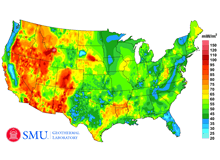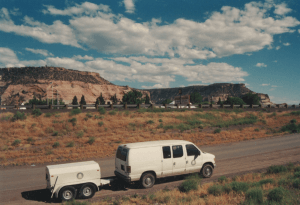Sunday, September 11, 2016
Aboard the Norseman II – Finally!
By Madie Jones (Master’s student, SMU)
Today is our 6th day in Alaska and I can happily say that we have FINALLY made it safely onto the Norseman II. After the weather in Wainwright failed to clear up enough for a flight out of Anchorage….three days in a row…we decided to change up the plans a bit and board out of Prudhoe Bay instead. Friday and Saturday morning started off with disappointing weather updates from Wainwright: low visibility caused by fog and seas too rough for a crew change.

Chugach Range in the background.
We got to know Anchorage pretty well by our 5th day, eating out at restaurants for pretty much every meal and exploring downtown with the truck that our travel coordinators let us borrow. Side note, if anyone ever visits Anchorage let me know and I’ll give ya some great food recommendations. On Saturday, Matt, Ben and I decided to go on another hike. We chose an 8.7 mile hike down and back to Wolverine Peak at an elevation of about 4200 ft. It took us 5 hours, but the views from the top were incredible and definitely worth the struggle it took to get up there.

background.
This morning we woke up bright and early to fly to Deadhorse in Prudhoe Bay. Once we landed we were driven to the port to get water-taxied out to the Norseman II, which was about 3 miles offshore. The drive through Deadhorse was eerie – this is such a remote, strange part of the world. I’ll explain Deadhorse by quoting our driver, Roger, who said: “The best way to describe Deadhorse is by what it isn’t. No one gets their mail here, there are no kids, no pets, no streetlights. It’s not a city, it’s just a place.” We drove by camps built for oil and gas workers who live here on and off for 2 weeks at a time. Pipelines and huge abandoned rigs cover ground for as far as the eye can see.

The boat ride out to our ship and the boat transfer/crew change went down without a hitch and now we’re here working on the Norseman II for the next 10 days! We spent the rest of the day setting up the heat flow probe and chirp equipment, meeting the crew and getting adjusted to life at sea. Now that most of the equipment appears to be ready to go, we have a 12-hour steam to our first data collection site. Here are some pictures of us getting equipment set up, which took all day and a lot of patience on everyone’s part. But it’s also really fun and exciting because we’re finally doing the cool part! This is, after all, the whole reason we’re here.


So that’s it! We’re off to a great start aboard the Norseman II and we’re all looking forward to our first heat flow probe deployment in 12 hours. You can follow our voyage on the Norseman II by clicking here. More updates to come, but for now we’re all going to rest up for a big day of data collection and new challenges.














